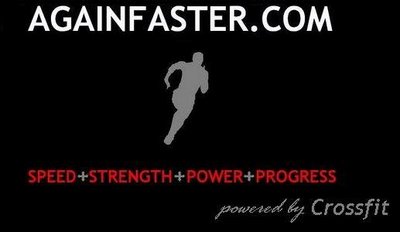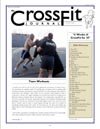Overhauling the Engine

Here at Again Faster, my preoccupation with power is well documented. I’m not talking Napoleon-marches-on-Russia power, but rather power in the classical physics sense.
Power is equal to work over time, and is variously measured using watts, horsepower, foot-pounds per minute, joules, or any derivation thereof.
Power = work/time
This metric serves as a brilliant conceptual umbrella for explaining Crossfit. During any given workout, we’re trying to maximize power, either by increasing work, reducing time, or both. In a workout such as “Cindy” (as many rounds as possible in twenty minutes, five pullups, ten pushups, and fifteen squats), we’re holding time constant while we attempt to increase the amount of work performed, thereby increasing power. In a workout such as “Fran” (21-15-9, thrusters and pullups), we’re holding work constant while we attempt to minimize the amount of time it takes to complete—again, increasing power.
The power equation is simple, but deviously so. Before any athlete can maximize work or minimize time, he or she must maximize a third variable—strength.
When you begin Crossfitting, your strength base is the equivalent of a four-cylinder engine. Over time, you become more adept at recruiting this strength base to move external objects and your own bodyweight, and your power output goes up. You’ve tuned your engine.
Still, you’re driving a four-banger, and you’ll quickly reach the apex of your output potential. After all, you can only tune that bugger so much.
If you want to up your output further, you’ll need to get a bigger engine. This is where dedicated strength training comes into play. Heavy deadlifts, squats, presses, and Olympic lifts, practiced regularly and to the exclusion of metabolic conditioning, will give you this bigger engine. There are many programs that are effective in this arena. The Hatch Squat Program and the Performance Menu Mass Gain Program have both worked well for me in the past. I guarantee that six weeks of dedicated strength training will turn your four-banger into a V-6, and you’ll have whole new powerblock to tune.
If you’ve recently failed to set a personal record on any of the benchmark workouts, go get yourself a bigger engine through strength training. After six weeks, stop back by the Crossfit performance shop. There, you can tune your bigger engine to new levels of power output, expressing your increased strength through decreased WOD times and increased metabolic capacity.
Don’t be surprised if the first few weeks back from the squat rack are difficult. Your body will need some time to readapt to the wallop that is Crossfit. After a month of rebuilding your metabolic base, try those benchmarks again. If you don’t set a PR, I’ll sell this site to those fitness wizards over at Men’s Journal.
Go faster!
Picture courtesy of moparpowerclub.com. Hatch Squat Program courtesy of Coach Mike Burgener over at Mike's Gym. Performance Menu Mass Gain Template, created by Greg Everett and Robb Wolf and translated to Excel by Jeff Dale, courtesy of The Performance Menu.

Here at Again Faster, my preoccupation with power is well documented. I’m not talking Napoleon-marches-on-Russia power, but rather power in the classical physics sense.
Power is equal to work over time, and is variously measured using watts, horsepower, foot-pounds per minute, joules, or any derivation thereof.
Power = work/time
This metric serves as a brilliant conceptual umbrella for explaining Crossfit. During any given workout, we’re trying to maximize power, either by increasing work, reducing time, or both. In a workout such as “Cindy” (as many rounds as possible in twenty minutes, five pullups, ten pushups, and fifteen squats), we’re holding time constant while we attempt to increase the amount of work performed, thereby increasing power. In a workout such as “Fran” (21-15-9, thrusters and pullups), we’re holding work constant while we attempt to minimize the amount of time it takes to complete—again, increasing power.
The power equation is simple, but deviously so. Before any athlete can maximize work or minimize time, he or she must maximize a third variable—strength.
When you begin Crossfitting, your strength base is the equivalent of a four-cylinder engine. Over time, you become more adept at recruiting this strength base to move external objects and your own bodyweight, and your power output goes up. You’ve tuned your engine.
Still, you’re driving a four-banger, and you’ll quickly reach the apex of your output potential. After all, you can only tune that bugger so much.
If you want to up your output further, you’ll need to get a bigger engine. This is where dedicated strength training comes into play. Heavy deadlifts, squats, presses, and Olympic lifts, practiced regularly and to the exclusion of metabolic conditioning, will give you this bigger engine. There are many programs that are effective in this arena. The Hatch Squat Program and the Performance Menu Mass Gain Program have both worked well for me in the past. I guarantee that six weeks of dedicated strength training will turn your four-banger into a V-6, and you’ll have whole new powerblock to tune.
If you’ve recently failed to set a personal record on any of the benchmark workouts, go get yourself a bigger engine through strength training. After six weeks, stop back by the Crossfit performance shop. There, you can tune your bigger engine to new levels of power output, expressing your increased strength through decreased WOD times and increased metabolic capacity.
Don’t be surprised if the first few weeks back from the squat rack are difficult. Your body will need some time to readapt to the wallop that is Crossfit. After a month of rebuilding your metabolic base, try those benchmarks again. If you don’t set a PR, I’ll sell this site to those fitness wizards over at Men’s Journal.
Go faster!
Picture courtesy of moparpowerclub.com. Hatch Squat Program courtesy of Coach Mike Burgener over at Mike's Gym. Performance Menu Mass Gain Template, created by Greg Everett and Robb Wolf and translated to Excel by Jeff Dale, courtesy of The Performance Menu.




















2 Comments:
Thanks for your insight on exertional headaches today. Good stuff.
I've been in the CF classes run by Russ Green, Jerry Hill, Jen Conlin, and skipper Tom Brpse at CrossfitDC. I've had the AF pull-up bar recommended to me be more than one person.
Thanks for this forum and your continued commitment to CrossFit.
hey Jon,
I just came across this post. I have been CrossFitting at least a year now, but I was feeling a little defficient when it came to strength, especially overhead strength. I've begun an "overhaul" of sorts, starting with Rippetoe's Starting Strength program. It's a lot of fun, might be awhile before I get back to straight CrossFit...
Post a Comment
<< Home